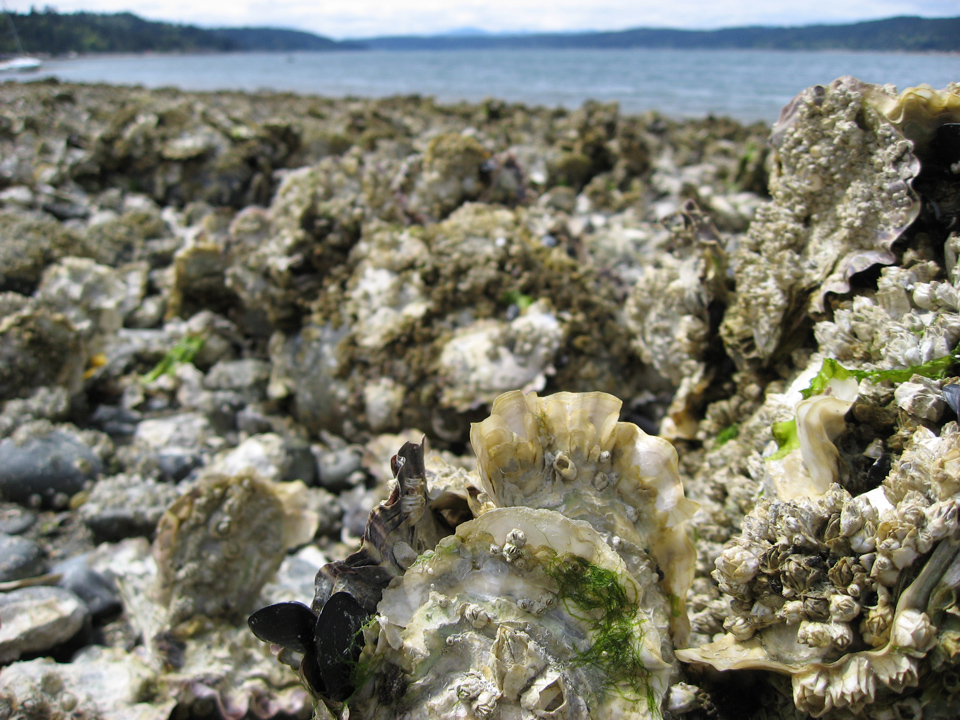In this morning’s Seattle Times, a spokesman for Taylor Shellfish reiterated a point the oyster industry has been making since news broke that oyster growers planned to use a neurotoxin called imidacloprid to kill native shrimp that create problems for their oyster farms: the media is getting it wrong.
Bowing to the fact that spraying watery oyster beds with a chemical whose label clearly states it should not be exposed to water is never going to look good in the press, Taylor Shellfish said over the weekend that it was abandoning its plan to use the chemical. Still, company spokesman Bill Dewey maintains that the coverage of the spray plan has caused some “serious misunderstanding”: the stuff is safe, he insists.
That may or may not be true, but what’s playing out today out in Washington’s Willapa Bay bears some striking parallels to some headlines a few years ago, when non-native oysters were facing another menace: ocean acidification. But crucially, the oyster industry that time was on the other side of the alarm.
Specifically, an extensive investigation by the Seattle Times looked into how burning fossil fuels is making sea water more acidic. As a package, the stories produced by Craig Welch seemed beyond reproach, and before I go on I should say that I continue to find them a estimable piece of journalism. But Seattle’s resident climate scientist Cliff Mass had a bone to pick with how Welch covered it, and zeroed in on Welch’s treatment of Taylor Shellfish and other oyster producers in the region. Mass, too, thought the paper was creating some “serious misunderstanding,” to borrow Dewey’s words.
Welch, citing people in the industry and independent scientists, claimed that human-caused ocean acidification was causing oyster larvae to have undeveloped shells, meaning they could not mature into something you and I would want to eat. The problem had gotten so bad that some oyster producers were moving production over the Hawaii, “ocean acidification refugees,” the Times called them. Taylor Shellfish itself wasn’t planning on moving, but was cited in the story.
But Mass raised an obvious point: The oysters are not native–
“It is very interesting to note that dying baby Pacific oysters headlined in the Seattle Times piece are not natives. They were imported during the early 20th century from Japan, a location without the large upwelling variations prevalent along the western side of the Pacific. My research so far suggests that our native shellfish species are doing fine….happy as a clam, so to speak. You might even have noticed the headlines of the record razor clam season we are having.”
(Welch himself acknowledges the nonnative issue, saying that native oysters aren’t experiencing the same kinds of die-offs, but doesn’t dwell on the point. Following Mass’s post, though, a fun little pissing match erupted between the Times and Cliff).
The current issue with the pesticides features the same dynamic. Again, it’s the death nonnative Pacific oysters that are causing the most concern (because they are they biggest cash crop for the oyster growers), while the shrimp in question–that is, the shrimp the industry wants to douse with pesticides–are native.
The big point here isn’t that the oyster industry is getting a taste of its own medicine when it comes to sounding the environmental alarms. Rather, both the struggles with ocean acidification and the struggle with native shrimp seem to come down to the same issue: It’s hard to grow things in an environment they didn’t evolve to grow in. The oyster industry is hardly the only one to learn this lesson. To cite just one other example, we killed nearly all the bison on the Great Plains in favor of European cows, only to curse when they proved to be less adept at dealing with the cold high plains winters (among other inferiorities compared to the native bison).
That doesn’t mean that farmers and ranchers have no business trying to raise non-native plants and animals. I enjoy beef, and Washington oysters. But when you pick a fight with evolution or nature, the stakes of the battle can escalate quickly. Before entering the battlefield, it’s always good to know what you’re getting into, burrowing shrimp and acidic water included.
dperson@seattleweekly.com








